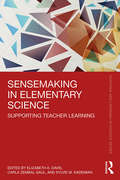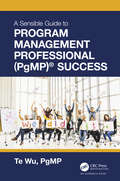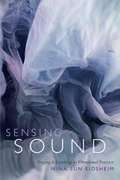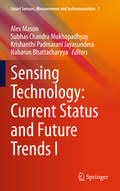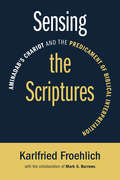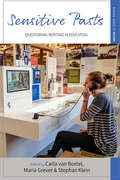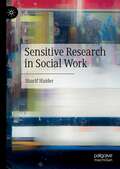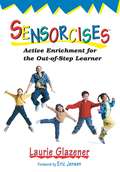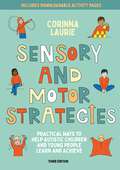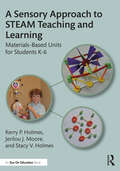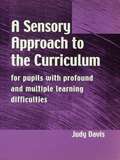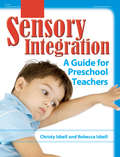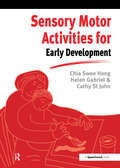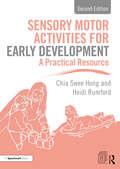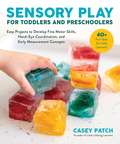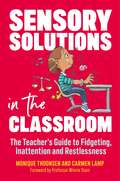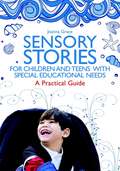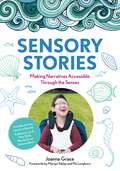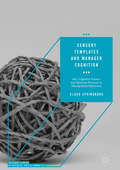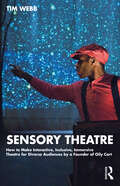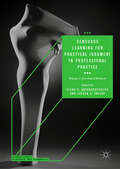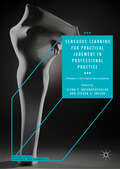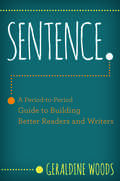- Table View
- List View
Sensemaking in Elementary Science: Supporting Teacher Learning (Teaching and Learning in Science Series)
by Elizabeth A. Davis Carla Zembal-Saul Sylvie M. KademianGrounded in empirical research, this book offers concrete pathways to direct attention towards elementary science teaching that privileges sensemaking, rather than isolated activities and vocabulary. Outlining a clear vision for this shift using research-backed tools, pedagogies, and practices to support teacher learning and development, this edited volume reveals how teachers can best engage in teaching that supports meaningful learning and understanding in elementary science classrooms. Divided into three sections, this book demonstrates the skills, knowledge bases, and research-driven practices necessary to make a fundamental shift towards a focus on students’ ideas and reasoning, and covers topics such as: An introduction to sensemaking in elementary science; Positioning students at the center of sensemaking; Planning and enacting investigation-based science discussions; Designing a practice-based elementary teacher education program; Reflections on science teacher education and professional development for reform-based elementary science. In line with current reform efforts, including the Next Generation Science Standards (NGSS), Sensemaking in Elementary Science is the perfect resource for graduate students and researchers in science education, elementary education, teacher education, and STEM education looking to explore effective practice, approaches, and development within the elementary science classroom.
The Sensible Guide to Program Management Professional (PgMP)® Success
by Te WuA Sensible Guide to Program Management Professional (PgMP)® Success is for program managers preparing to take the PgMP exam based on The Standard for Program Management – 4th Edition (PgM4 Standard). It is designed for busy professionals whose responsibilities have taken them into the realm of coordinating, facilitating, managing, and leading programs. Program managers are leaders who are directly managing large amounts of project resources for their organizations. This study guide addresses three main concerns facing PgMP exam candidates: What are the essential concepts, processes, and tools that form the foundation of today’s program management? Since program management is still an emerging profession with professionals often working in different ways, what does this mean for a "standard" exam? More specifically, how does that impact your ability to pass the PgMP exam? What is the best way to prepare for the PgMP exam? To address the first concern, this book highlights the underlying rationale for program management: why it exists in organizations; why it is becoming ever more important; what programs are, especially for the purpose of passing the exam; how to think like a portfolio manager; and what the most important concepts, processes, and tools are for this profession. By simplifying complex ideas and communicating them in plain English with relevant examples, this book aims to help readers not only to pass the PgMP exam but also to serve as an essential guide for program managers. For the second concern, this book differs from other study guides by describing the author’s personal experience as a program manager and addressing the most pressing questions for each of the performance domains in The Standard for Program Management. To address the last concern, this book contains 420 practice questions, access to an online exam simulator and an online PgMP community, and a time-tested approach for passing the PgMP exam.
Sensing Sound: Singing and Listening as Vibrational Practice
by Nina Sun EidsheimIn Sensing Sound Nina Sun Eidsheim offers a vibrational theory of music that radically re-envisions how we think about sound, music, and listening. Eidsheim shows how sound, music, and listening are dynamic and contextually dependent, rather than being fixed, knowable, and constant. She uses twenty-first-century operas by Juliana Snapper, Meredith Monk, Christopher Cerrone, and Alba Triana as case studies to challenge common assumptions about sound--such as air being the default medium through which it travels--and to demonstrate the importance a performance's location and reception play in its contingency. By theorizing the voice as an object of knowledge and rejecting the notion of an a priori definition of sound, Eidsheim releases the voice from a constraining set of fixed concepts and meanings. In Eidsheim's theory, music consists of aural, tactile, spatial, physical, material, and vibrational sensations. This expanded definition of music as manifested through material and personal relations suggests that we are all connected to each other in and through sound. Sensing Sound will appeal to readers interested in sound studies, new musicology, contemporary opera, and performance studies.
Sensing Technology: Current Status and Future Trends II
by Nabarun Bhattacharyya Krishanthi Padmarani Jayasundera Subhas Chandra Mukhopadhyay Alex MasonThis book is written for academic and industry professionals working in the field of sensing, instrumentation and related fields, and is positioned to give a snapshot of the current state of the art in sensing technology, particularly from the applied perspective. The book is intended to give broad overview of the latest developments, in addition to discussing the process through which researchers go through in order to develop sensors, or related systems, which will become more widespread in the future.
Sensing the Scriptures: Aminadab's Chariot and the Predicament of Biblical Interpretation
by Karlfried FroehlichThis book explores the ways that Christians, from the period of late antiquity through the Protestant Reformation, interpreted the Bible according to its several levels of meaning. Using the five bodily senses as an organizing principle, Karlfried Froehlich probes key theological developments, traditions, and approaches across this broad period, culminating in a consideration of the implications of this historical development for the contemporary church.Distinguishing between "principles" and "rules" of interpretation, Froehlich offers a clear and useful way of discerning the fundamental difference between interpretive methods (rules) and the overarching spiritual goals (principles) that must guide biblical interpretation. As a study of roots and reasons as well as the role of imagination in the development of biblical interpretation, Sensing the Scriptures reminds us how intellectually and spiritually relevant the pursuit of a historical perspective is for Christian faith and life today.
Sensitive Pasts: Questioning Heritage in Education (Making Sense of History #27)
by Carla Van Boxtel Maria Grever Stephan KleinHeritage, as an area of research and learning, often deals with difficult historical questions, due to the strong emotions and political commitments that are often at stake. In this, it poses particular challenges for teachers, museum educators and the publics they serve. Guided by a shared focus on these “sensitive pasts,” the contributors to this volume draw on new theoretical and empirical research to provide valuable insights into heritage pedagogy. Together they demonstrate the potential of heritage as a historical-educational domain that transcends myopic patriotism, parochialism and simplistic relativism, helping to enhance critical and sophisticated historical thinking.
Sensitive Research in Social Work
by Sharif HaiderThis book addresses issues related with researching sensitive topics in social work, focusing on marginalized, vulnerable and hard to reach people. It covers the definition, characteristics, challenges and opportunities of sensitive research, its philosophical roots and methodological debates, and the skills and values that are required along with the ethical, political and legal issues involved in conducting social work research. This book will cover innovative research methods appropriate for research on sensitive topics involving vulnerable people. It shines light on how to use traditional research methods sensitively, and how to generate data while minimizing the harm that can potentially be caused to research participants and researchers.
Sensorcises: Active Enrichment for the Out-of-Step Learner
by Laurie GlazenerGet moving to prime the body for learning!All young students sometimes need a little extra help developing their senses. And many kids who are labeled as "problem students" simply lack the physical skills necessary to sit still, pay attention or even hold a pencil. Sensorcises helps students develop the very basic sensory skills needed for learning. Learn how to address the needs of these learners and help them develop the sensory motor skills they need to succeed.In this invigorating book, the author explores the REAL technique-Relax, Energize, Activate and Lead. By providing clear, step-by-step instructions, this book shows you how to design activity sequences to help students with sensory dysfunction as well as all the other learners in your K-5 classes. The author makes it incredibly easy to incorporate these exercises into any curriculum. Each research-based activity is fully described and illustrated with photographs to assist with classroom implementation.You AND your whole class will benefit from Sensorcises! They are the perfect way to boost energy levels while helping students focus their mind, body, and senses on achieving success.
Sensory and Motor Strategies (3rd edition): Practical Ways to Help Autistic Children and Young People Learn and Achieve
by Corinna LaurieIn this fully revised third edition, Corinna Laurie sets out practical strategies to help autistic children develop their sensory and motor skills. Learn to identify possible challenges, recognise signs of overload and work in a co-productive way with your student or child, developing sensory regulation strategies and improving motor skills to aid well-being.The simple, low-cost activities provide practical solutions to help children meet the demands of any situation, building skills from handwriting and using scissors to improving posture, co-ordination and motor planning. Sensory strategies include calming techniques and simple environmental modifications to prevent overwhelm, among many others.Helping to improve functional abilities and enable children to thrive and build independence, this is an essential resource for anyone working with children on the autism spectrum.
A Sensory Approach to STEAM Teaching and Learning: Materials-Based Units for Students K-6
by Kerry P. Holmes Jerilou J. Moore Stacy V. HolmesDid you know you have the power and the materials at your fingertips to facilitate the actual brain growth of students? This book is a practical resource to engage K-6 students with STEAM content through their five senses: seeing, listening, touch/movement, smell and taste. It combines historical research, practical suggestions, and current practices on the stages of cognitive development and the brain’s physical response to emotion and novelty; to help you learn ways to transform ordinary lesson plans into novel and exciting opportunities for students to learn through instruction, exploration, inquiry, and discovery. In addition to providing examples of sensory-rich unit plans, the authors take you through the step-by-step process on how to plan a thematic unit and break it down into daily seamless lesson plans that integrate science, technology, engineering, arts, and mathematics. With 25 themed STEAM unit plans and activities based on national standards, up-to-date research on brain science, and real classroom experience, this book shows multiple ways to develop and deliver active multisensory activities and wow your students with sights and sounds as soon as they come through the door of your classroom.
A Sensory Approach to STEAM Teaching and Learning: Materials-Based Units for Students K-6
by Kerry P. Holmes Jerilou J. Moore Stacy V. HolmesDid you know you have the power and the materials at your fingertips to facilitate the actual brain growth of students?This book is a practical resource to engage K-6 students with STEAM content through their five senses: seeing, listening, touch/movement, smell and taste. It combines historical research, practical suggestions, and current practices on the stages of cognitive development and the brain’s physical response to emotion and novelty; to help you learn ways to transform ordinary lesson plans into novel and exciting opportunities for students to learn through instruction, exploration, inquiry, and discovery.In addition to providing examples of sensory-rich unit plans, the authors take you through the step-by-step process on how to plan a thematic unit and break it down into daily seamless lesson plans that integrate science, technology, engineering, arts, and mathematics.With 25 themed STEAM unit plans and activities based on national standards, up-to-date research on brain science, and real classroom experience, this book shows multiple ways to develop and deliver active multisensory activities and wow your students with sights and sounds as soon as they come through the door of your classroom.
A Sensory Approach to the Curriculum: For Pupils with Profound and Multiple Learning Difficulties
by Judy DavisWritten by a teacher with many years of experience with pupils with PMLD, this book offers a well-tried approach to delivering the curriculum, with particular emphasis on the core subjects. It aims to complement and supplement existing material and provides a useful resource for busy teachers.
Sensory-Balance: An Approach to Learning Media Assessment for Students With CVI
by Christine Roman-Lantzy Matthew TietjenThe current leading cause of visual impairment among children is not a disease or condition of the eyes, but cortical visual impairment (CVI)-also known as cerebral visual impairment-in which visual dysfunction is caused by damage or injury to the brain. The definition, nature, and treatment of CVI are the focus of great concern and widespread debate, and this complex condition poses challenges to professionals and families seeking to support the growth and development of visually impaired children. On the basis of more than 30 years' experience in working with hundreds of children of all ages with CVI, Christine Roman-Lantzy has developed a set of unique assessment tools and systematic, targeted principles whose use has helped children learn to use their vision more effectively. This one-of-a-kind resource provides readers with both a conceptual framework with which to understand working with CVI and concrete strategies to apply directly in their work.
Sensory Integration: A Guide for Preschool Teachers
by Rebecca Isbell Christy IsbellDo you have a child in your early childhood classroom who:*Climbs on top of furniture and jumps off? *Covers his ears when children are singing? *Refuses to touch clay, paint, or sand? *Often falls down and skins her knees? *Refuses to play on outdoor playground equipment?If so, it is possible the child is having sensory processing problems. How can you help children with these problems so they can enjoy learning and grow in positive ways? Sensory Integration helps you identify children who have difficulties with sensory processing, and it offers simple, easy-to-use solutions to support the sensory needs of young children in the preschool classroom. Easy-to-implement solutions include adaptations and activities for children with different types of Sensory Processing Disorder. This book has a bonus chapter with instructions for creating low-cost items to help children with sensory issues.Chapters cover concepts such as:*Explaining Sensory Integration and Sensory Processing Disorder*Defining sensory avoiders, seekers, and under-responders*Designing the environment to support the sensory development of all children*Helping preschoolers with sensory processing problems*Providing practical solutions to meet the needs of individual children during daily routines*Building and creating low-cost items such as a tire swing, sand pillow, and incline board to give children opportunities to get the sensory input they need
Sensory Motor Activities for Early Development: A Practical Resource
by Chia Swee Hong Helen GabrielThis is a successful manual of tried and tested activities to develop gross and fine motor skills in children. It contains: Numerous creative activities to stimulate sensory and body awareness, encourage basic movement, promote hand skills and enhance spatial/perceptual skills; Information on working in small groups; Handouts that can be photocopied to give to parents or other carers for home practice.
Sensory Motor Activities for Early Development: A Practical Resource
by Chia Swee Hong Heidi RumfordSensory motor activities are crucial for children to learn from their environment. Bridging the gap between theory and practice, this revised edition is a complete package of tried-and-tested sensory motor activities for children, covering basic movements, interoception, sensory and body awareness and early visual perceptual skills. Providing an overview of the sensory systems, the authors offer practical strategies for parents/carers and practitioners to link knowledge to practice when communicating and engaging with a child. The authors present both familiar and novel activity ideas, explaining how they provide sensory stimulation to the relevant sensory systems and may help to support the child’s development, sensory processing and regulation levels. New material includes: greater emphasis on understanding the sensory systems and how they link to the activities a brand new chapter on interoception revised recording methods, including Goal Attainment Scaling as an outcome tool an expanded list of activities. Sensory Motor Activities for Early Development, 2nd edition is an essential text for all parents/carers and practitioners who use sensory motor activities in a playful way to help the development of children with a range of needs. It will be valuable reading for those working with children who do not initiate movement, who require help with their movement, who need to refine their movement, who need encouragement or motivation to engage in purposeful movements, or those who need activities to provide sensory stimulation.
Sensory Play for Toddlers and Preschoolers: Easy Projects to Develop Fine Motor Skills, Hand-Eye Coordination, and Early Measurement Concepts
by Casey PatchExplore taste-safe small worlds, create colorful pieces of art, and engage all five senses while investigating the great outdoors. Sensory play is a wonderful way to explore the world with your little learners!Sensory Play for Toddlers and Preschoolers is a practical, hands-on guide for parents and educators who want to inject more play into their children's day! Since this collection features simple sensory play ideas with items you already have in your home, playtime has never been easier. Inside the book, you&’ll find forty easy sensory play tubs and activities with extra bonus ideas for extending the activities even further! Not only will your child be learning and exploring through play, but you&’ll also be creating some magical memories of playtime that will last a lifetime! Learn how to get started with sensory play using tips, tricks, and sensory play staples.Follow quick and easy, tried and tested sensory base recipes designed to ignite the senses and inspire hours of sometimes messy, always memorable playtime.Create thoughtful sensory invitations and artworks while developing fine motor skills, hand-eye coordination, early measurement concepts and so much more! Sensory play allows our little learners to make connections as they explore the world around them using their senses of sight, smell, taste, sound, and touch. It&’s the beginning of a lifelong journey of scientific understanding and a wonderful way to connect and bond with your little learners! Projects include: Rainbow RiceCloud DoughSand FoamEdible MudWater TubRainbow SpaghettiFrozen Building BlocksOutdoor KitchenJell-O Bug RescueBubble Wrap Paintingsand more!
Sensory Solutions in the Classroom: The Teacher's Guide to Fidgeting, Inattention and Restlessness
by Carmen Lamp Monique ThoonsenEvery teacher knows them - the students who are continuously balancing on their chair legs or who prefer to hide in their hoodies all day long. These students are using all kinds of tricks to be able to stay focused, as they are under- or overresponsive to sensory input and trying to restore their balance.Children who struggle with processing sensory input can experience a wide range of symptoms, including hypersensitivity to sound, sight and touch, poor fine motor skills and easy distractibility. Using this accessible, science-based guide, school staff can support these students by understanding their symptoms and how they impact their learning. Teachers can learn to look at students in a different way: through so-called 'SPi glasses', introduced in the book. With these glasses on, you learn to recognize behaviours linked to sensory processing and respond quickly, easily and with more understanding, without using a diagnosis, medication or therapy. The techniques provided help children feel settled and soothed at school, enabling them to learn and communicate better. Creating the perfect learning environment for all students - a sensory supportive classroom - this tried and tested guide is an essential tool for teachers (with or without prior knowledge of SPD), to better support and understand their students and their sensory needs.
Sensory Stories for Children and Teens with Special Educational Needs: A Practical Guide
by Joanna GraceSensory Stories are short stories of a few lines which are brought to life through a selection of meaningful sensory experiences. They are particularly beneficial for students with Sensory Processing Disorder (SPD), profound and multiple learning difficulties (PMLD), autism spectrum disorders (ASD) and other special educational needs (SEN). For children with PMLD, Sensory Stories can open up new avenues for communication and inclusive learning. For students with SPD and ASD, they offer a fun way of encountering sensory experiences and triggers in a safe, repetitive way, which over time can help to reduce associated anxieties. This accessible guide offers teachers, other professionals working with students with SEN and parents with a complete step-by-step guide to creating and using Sensory Stories effectively. Aiming to make Sensory Stories affordable and accessible to schools and parents alike by using everyday items found in the classroom and home, Joanna Grace provides original, ready-to-use Sensory Stories with accompanying lesson plans, games and activities and adaptations for different abilities and diagnoses. Written by an experienced SEN consultant and sensory learning specialist, this is unique and essential reading for teachers, other professionals and parents wishing to introduce the many benefits of multi-sensory storytelling to children in their care.
Sensory Stories to Support Additional Needs: Making Narratives Accessible Through the Senses
by Joanna GraceSensory Stories are short stories of a few lines which are brought to life through a selection of meaningful sensory experiences. They are particularly beneficial for people with Sensory Processing Disorder (SPD), Profound and Multiple Learning Difficulties (PMLD) and Autistic children or adults. Sensory stories are perfect for introducing new sensory environments in a safe, interactive way to help reduce associated anxieties and open up new avenues for communication and play.This updated edition is packed with original ready-to-use sensory stories, including 5 additional guest sensory stories by authors from around the world and your very own story template to create a sensory experience personalised for each person. With exclusive 'how to' video content and digital lesson plans, this book is the essential tool for introducing the transformative multi-sensory storytelling method into your home, classroom or group setting.Using everyday items and step-by-step instructions to make incorporating sensory stories accessible and simple, it has never been easier to create inclusive and fun sensory experiences to enhance the lives of those with additional needs.
Sensory Templates and Manager Cognition: Art, Cognitive Science And Spiritual Practices In Management Education (Palgrave Studies In Business, Arts And Humanities Ser.)
by Claus SpringborgThis book explores the role of art and spiritual practices in management education. It takes recent developments in cognitive science relating to the metaphorical and embodied nature of cognition as its starting point. Introducing the concept of ‘sensory templates’, Springborg demonstrates how managers unconsciously understand organizational situations and actions as analogous to concrete sensorimotor experiences, such as pushing, pulling, balancing, lifting, moving with friction, connecting and moving various substances. Real-life management and leadership case studies illustrate how changing the sensory templates one uses to understand a particular situation can increase managerial efficiency and bring simple solutions to problems that have troubled managers for years. Sensory Templates and Manager Cognition will be of interest to scholars and students of managerial cognition, leadership and neuroscience, as well as practising managers and management educators.
Sensory Theatre: How to Make Interactive, Inclusive, Immersive Theatre for Diverse Audiences by a Founder of Oily Cart
by Tim WebbSensory Theatre: How to Make Interactive, Inclusive, Immersive Theatre for Diverse Audiences by a Founder of Oily Cart is an accessible step-by-step guide to creating theatre for inclusive audiences, such as young people on the autism spectrum or affected by other neuro-divergent conditions and children under two. Conventional theatre relies on seeing and hearing to involve its audience; sensory theatre harnesses the power of five or more senses to address its participants who have different ways of relating to the world around them. This book is an insightful history of Oily Cart and its pioneering development of work for the very young, including Baby Theatre, and for neuro-divergent audiences including those on the autism spectrum. It gives a clear introduction to the fundamental concepts of this theatre, suggests a host of practical techniques drawn from over forty years of experience, and describes some of Oily Cart’s most radical innovations, including theatre on trampolines, in hydrotherapy pools, and with flying audiences in the company of aerial artists. The book also includes copious photos from the Oily Cart’s archives and links to videos examples of the company’s work. Readers will learn how to: Research the intended audience while not being led astray by labels. Create a welcoming, immersive sensory space in classrooms, nurseries, school halls, and playgrounds. Devise sensory stories that can be adapted to suit different audiences. Recruit, audition, cast, and run rehearsals. Ensure that the production is truly sensory and interactive. Written for Theatre for Young Audiences, Drama in Education, and specialized Applied Theatre courses, as well as educators and theatre practitioners interested in creating inclusive, interactive productions, Sensory Theatre offers a goldmine of ideas for making work that connects with audiences who can be the hardest to reach.
Sensuous Learning for Practical Judgment in Professional Practice: Volume 1: Arts-based Methods (Palgrave Studies in Business, Arts and Humanities)
by Elena P. Antonacopoulou Steven S. TaylorThe first volume of this ground-breaking book critically examines how and why arts-based methods such as choir conducting workshops and dialogue improvisation can make a difference in improving professional practice. Taking a ‘human-centred’ approach, it delivers an insightful account of what these approaches do differently to achieve a new mode of learning – ‘sensuous learning’ – that cultivates professional judgment to serve the common good, simultaneously supporting personal and collective growth. The chapters present cutting edge examples of multiple ways arts-based methods underpin learning arenas for expanding leadership and improving professional practice. The reflexivity cultivated through these learning arenas has the unique potential to improve professional practice, not merely by enhancing competence but also by cultivating character and conscience, which is central in making judgments that serve the common good. These benefits are relevant for professional practitioners sharpening the skills and behaviours needed in organisations, including creativity, diversity, imagination, and improvisation.
Sensuous Learning for Practical Judgment in Professional Practice: Volume 2: Arts-based Interventions (Palgrave Studies in Business, Arts and Humanities)
by Elena P. Antonacopoulou Steven S. TaylorThe second volume of this ground-breaking book critically examines the effect of arts-based methods in combination as arts-based interventions in improving professional practice, from deinstitutionalization to the counteraction of destructive leadership. Taking a ‘human-centred’ approach, it delivers an insightful account of what these approaches do differently to achieve a new mode of learning – ‘sensuous learning’ – that cultivates professional judgment to serve the common good, simultaneously supporting personal and collective growth. The chapters present cutting edge examples of multiple ways arts-based interventions underpin learning arenas for expanding leadership and improving professional practice. The reflexivity cultivated through these learning arenas has the unique potential to improve professional practice, not merely by enhancing competence but also by cultivating character and conscience, which is central in making judgments that serve the common good. These benefits are relevant for professional practitioners sharpening the skills and behaviours needed in organisations, including creativity, diversity, imagination, and improvisation.
Sentence.: A Period To Period Guide To Building Better Readers And Writers
by Geraldine WoodsSometimes it’s better to start small, with a sentence. Every English teacher has experienced it: students staring at an empty page, seemingly paralyzed by a writing assignment. When this happens, it may be time to back off from the Big Idea approach to the art of reading and writing, and zero in on a single sentence. In this book, a master teacher offers a complete guide to a sentence-level approach. Helping students recognize the techniques that make sentences great is the first step, and there are plenty of examples here from YA novels, TV shows, and song lyrics as well as the novels, poetry, and nonfiction pieces that form the canon of middle and high school reading lists. Lesson plans include activities to introduce the featured element of style; questions to guide students in their analysis; and writing prompts and activities to spark students’ interest and creativity. With this Little-to-Big strategy, students move quickly from analysis of the words between two periods to the universe of ideas of which that sentence is a part. They may even be eager to write their own
